Types Of Conjunction
Conjunctions are a form of part of speech in English that joins words, phrases, or clauses. We are obliged to convey complex phrases by dividing them down into small, simple sentences in the absence of conjunctions. These conjunctions are cleverly employed to communicate the same concept.
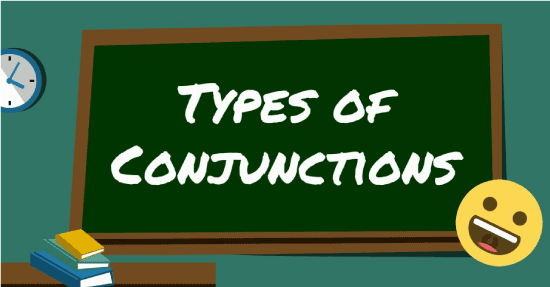
Conjunctions might be in the form of a single term, a compound word, or a correlative word. Depending on the type of conjunction employed, it can come at the start or in the midst of a sentence.
What Are Conjunctions?
Conjunctions aren’t that intriguing. They aren’t as detailed as nouns, as colorful as adjectives, or as lively as verbs. These small but powerful pieces of speech, , are a vital part of any write-up. Conjunctions of various forms can help you smooth out choppy writing, tie concepts together, and construct fluid, complicated sentences.
A Conjunction is a term that links two or more terms/words, phrases, or clauses in a sentence. It makes it simpler for us to inter-change these thoughts and build relationships. We’d have to make a lot of short, straightforward statements if they weren’t there. ‘And,’ ‘or,’ ‘but,’ and ‘because’ are the most typical instances.
Without conjunctions, you would be limited to using short, simple phrases to communicate your thoughts and complicated ideas:
- I enjoy sandwiches.
- I enjoy Waffles.
- I’m not a fan of lasagna.
Wouldn’t it sound a lot better if these statements were expressed as a single idea? As an example:
I enjoy sandwiches and waffles, but I don’t like lasagna.
Understanding conjunctions may help you add a lot of diversity to your writing by allowing you to produce sentences with a wide range of styles and meanings.
Conjunction Types
Conjunctions are classified into three types:
- Coordinating Conjunction
- Subordinating Conjunction
- Correlative Conjunction
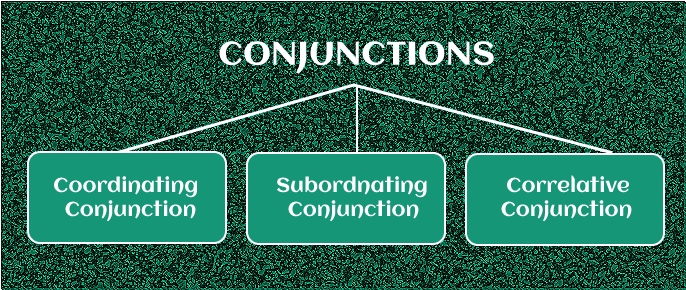
1. Coordinating Conjunction
The conjunction that unites two elements with similar syntactic significance and grammatical ranking is defined as a coordinating conjunction. These can also be utilized to connect two independent clauses or phrases or adjectives, or verb, or nouns.
The primary coordinating conjunctions include for, and, nor, but, or, yet, and so. The term FANBOYS makes it easy to recall these conjunctions. Among these conjunctions, “so” can function as both a coordinating and subordinating conjunction.
It can connect two independent clauses as coordinating conjunction and two unequal clauses as subordinate conjunction.
Let us have a look at a few examples of Coordinating Conjunction;
- I would like a hot dog or pasta for a meal.
- Martha enjoys going to the fitness center and walking.
- I can take you to the grocery shop, but not to the market.
Be careful not to overuse coordinating conjunctions, as this can result in run-on sentences.
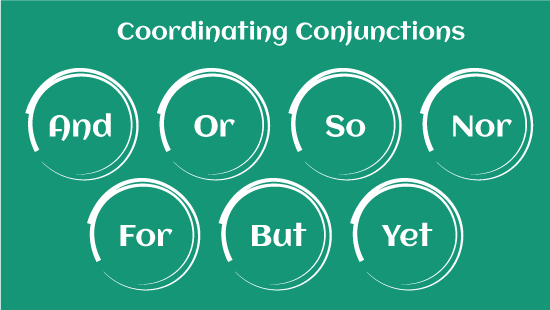
Rules of Coordinating Conjunctions
There are a few guidelines to be followed when using appropriate conjunctions and words in specific circumstances:
- A comma must be inserted before the coordinating conjunction when it joins two separate sentences.
For instance, I wished to go sightseeing, but my companion wanted to see a movie. - A comma is not placed in front of a coordinating conjunction while it is connecting two sentences or terms.
For instance, I enjoy biking and swimming. - A comma is a choice when using coordinating conjunction with more than two terms.
I went to the local shop and got veggies, chocolates, and milk.
2. Correlative Conjunctions
These are pairing conjunctions. They are sold in pairs and are used in various locations.
Most common types of Correlative Conjunctions include – either/or, as… as ; neither/nor, rather…than ; not only/but also, whether/or, not/but I’d like to either have chocolate or cookie. She neither wants pizza nor a burger.
When utilizing correlative conjunction, the correlative terms should come directly before the phrases you want to connect. Following are some examples:
- They can either accept it or reject it.
- I’m not only done with the cooking but also I am done vacuuming my room.
- Both my mother and brother are dentists.
Parallel construction is required for correlative conjunctions. Check the words following each conjunction to ensure they are similarly organized.
Correct: We must either purchase the passes ahead of time or come an hour ahead. (In this case, “purchase the passes” is analogous to “come an hour in advance.”)
Incorrect: We should purchase the passes ahead of time or be coming an hour ahead. (In this case, the word “purchase the passes” is not synonymous with “be coming”).
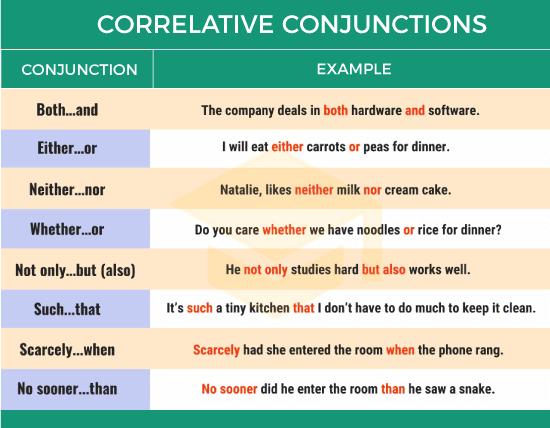
3. Subordinating Conjunction
Another type of conjunction is the subordinating conjunction. These are the conjunctions that assist connect dependent clauses to independent ones. Since, because, though, as, although, while, and whereas are some typical subordinating conjunctions.
Adverbs may also function as conjunctions in some cases. Common examples of the same are “until, after, or before.”
For instance, I can sit here until the bell rings.
The word “until” serves as a conjunction in this sentence, connecting two notions such as “can sit here” and “bell rings.”
Because the first notion is unrelated to the second, “can sit here” is an independent clause, while “bell rings ” is a dependent clause. The presence of subordinating conjunctions in the midst of a sentence is not required.
The subordinating conjunctions do not have to be in the center of the statement, but they must be part of the depending clause. The subordinate clause or subordinating sentences are other names for the dependent clause.
The dependent clause has two distinct characteristics.
- First, it cannot function as a sentence.
- Second, The independent clause is responsible for providing a comprehensive meaning.
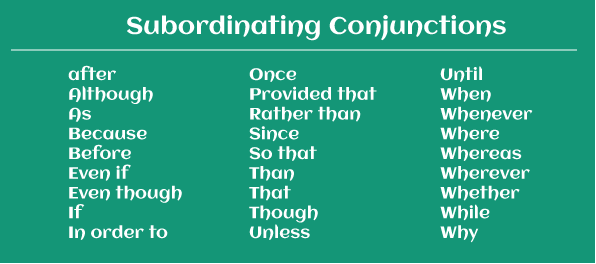
Types of Subordinating Conjunction
The following subordinating conjunctions are classified according to their meaning:
- Time: The time-related conjunctions specify a timeframe when the primary clause is or will be accomplished.
For instance: as soon as, once, before, yet, and whenever.
I’ll mop the room after the guests have left. - Concession: These conjunctions help redefine the main clause’s meaning by supplying extra information. It emphasizes the action that occurred in the barrier or obstacle.
As an example, consider the words although, even though, and as if.
Helen wrote my essay even though it was allotted to me. - Comparison: It aids in the establishment of the link between the words by giving a correlation.
As an example, consider the words though, whereas, similarly, and in contrast to.
You will finish the assignment quickly, whereas I might need more time. - Cause: It specifies why the main clause was carried out.
As an instance, consider the words because, since, so that.
My mom is always an inspiration to me because she trusts in me. - Condition: It specifies the rules that govern how the main clause operates.
As an example, consider the words if, in case, even if, and unless.
In case my husband likes this gown, then I will purchase it. - Place: It denotes the location of the action or activities.
Wherever, whereas are two examples.
I will put the chair wherever they are needed.
Conjunctive Adverbs
Conjunctive adverbs are adverbs in reality. However, they do serve as connectors; thus,, some grammar experts consider it a form of conjunction while others don’t. The fundamental function of a conjunctive adverb is to indicate a transition or relationship between two distinct parts of a sentence or phrase.
Common Conjunctive Adverbs
Here are some instances of conjunctive adverbs:
Also, Before Besides, However, Therefore, Hence, Otherwise, Nevertheless, Eventually, Thus Accordingly, Consequently, Furthermore, Likewise; Finally, and so on
A semicolon or period must appear in front of a conjunctive adverb, and a comma must come afterward. Consider the following examples:
- Danny is a fantastic musician; however, he hardly performs.
- The thick snow enveloped the streets; therefore, many individuals were stuck.
- I’ve never been a fan of vegetables. Nevertheless, I advise my children to eat them.
Combining Several Types of Conjunctions
It is permissible and alright to employ all the kinds/sorts of conjunctions in the same statement. Understand that coordinating conjunctions are used to link independent clauses, and subordinating conjunctions are utilized to link independent clauses to subordinate clauses. Sentences can become very lengthy and complex at times, but you must keep in mind when and where to use commas.
Read on to find the example of a complicated sentence that makes use of all three kinds of conjunctions. Make sure to remember that the coordinating conjunctions, that link two independent clauses, uses a comma:
I made an effort to convince my teacher and Principal that I was honest, but my strategy failed since both my friends and elders told them that I had shattered the window glass.
Conclusion
We may conclude from the definition and examples of conjunctions that they assist us in combining simpler phrases to form a single complex sentence. When inserting the comma, we must use extreme caution and ensure that the right conjunctions are utilized. A comma does not accompany conjunctions that occur in the center of a statement. If the subordinate clause comes initially in the sentence, the entire sentence is accompanied by a comma.
Conjunction usage is a tough subject, and mastering takes practice like most grammar principles. Understanding the many sorts of conjunctions is a necessary skill for any budding writer. Pay close attention to sentence form and clauses, and you’ll be connecting concepts like a pro in no time.
